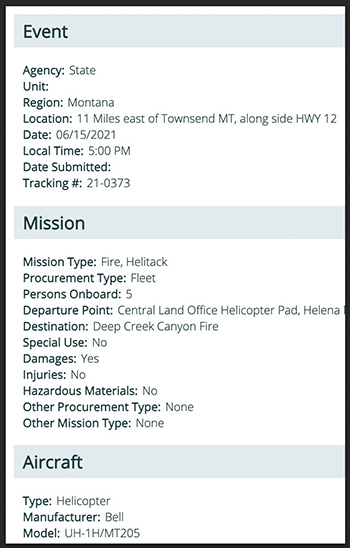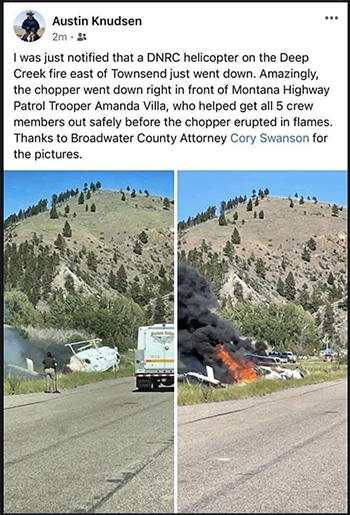
The SAFECOM report about the helicopter that crashed and burned while working on the Deep Creek Canyon Fire that had been posted and then removed, has reappeared on the website. It is possible that because it was originally posted only two days after the incident it needed to be fine-tuned to be sure it was accurate and complete.

The UH-1H/MT205 operated by the Montana Department of Natural Resources and Conservation suffered a hard landing, then rolled over and caught fire while attempting to land at a helispot June 15, 2021.

At the top of this article is the first section of the report. Below is the complete Narrative and Corrective Action.
Narrative
Hard Landing Incident Deep Creek Canyon Fire 15 June 2021. Approximately 1700 hrs, Bell MT 205 N398M. Pilot. The following is summary perspective by the pilot, of the events leading up to, as well as the hard landing incident on the Deep Creek Canyon Fire.
On 15 June 2021, N398M was dispatched at approximately 1520 to pick up a Helitack crew at the Central Land Office (CLO) to respond to the Deep Creek Canyon Fire. Aircraft N398M was dispatched from a fire it was working out of the Clinton Montana Volunteer Fire Department (VFD), direct to CLO. At the CLO N398M loaded a crew of 4, a Helicopter Manager, and 3 Helitack Crewmembers manifested with their equipment at 1110. N398M also topped off fuel to about 1400 lbs. The load calculation was based on worse case at 6,000 feet and 34 degrees Celsius, and all parameters for a safe takeoff and landing were met based on these calculations.
Takeoff from the CLO was uneventful, winds there were from the north west and aircraft power was as expected. Earlier in the day, en route to Clinton VFD fire a power assurance was completed with a final calculation 34 degrees cooler than the target.
As N398M approached the Deep Creek Canyon Fire, the pilot was monitoring traffic via air-to-air and at 12 miles out called air attack to request entry. They granted entry at or below 6,000 feet with altimeter setting of 2987. The pilot was aware from radio traffic to helicopter N388M, that it was returning to the dip and ordered to hold at the dip for a tanker drop. N398M pilot visually acquired N388M and about the same time N398M manager asked if the pilot had visual, which was affirmed. After passing behind N388M, the pilot of N398M noted that N388M had oriented to the South West at a hover.
As N398M approached the Helispot, the pilot contacted the manager of N388M who cleared the aircraft in. The pilot only caught part of his transmission but saw him gesture at the landing spot on the West end of the pull-off tarmac, and the N398M pilot observed evidence of winds from the blowing willows in the South West direction.
N398M crossed over the landing area into a left downwind approach to give the best visual of the landing area. Upon turning base and final from about 500 feet the N398M pilot immediately noticed the aircraft settling and felt he may be experiencing a nearly direct tailwind condition. N398M airspeed was approach speed at this point and did not have sufficient altitude to simply fly out of it as the aircraft was “mushing” through with little to no effect from applied collective. The pilot relaxed application of collective, expecting some help from ground effect, however that did not happen.
Realizing a hard landing was imminent and although the aircraft had not fully completed its final turn, the pilot leveled the helicopter as it impacted about 10 degrees off landing direction and some right lateral drift. At impact, the aircraft spun to the right about 120 degrees and rolled to the left and flipped upside down. The pilot released his belt buckle and fell into the top of the cockpit. The pilot was disoriented and stood upside down in the cockpit. The pilot quickly realized the engine was still running and struggled to locate the fuel shutoff switch and electrical cutoff switches. Eventually the pilot did locate the shutoff for fuel and also raked all the electrical switches into the aft position. As the pilot was doing this, he noticed the aircraft was on fire, and knew at least two crewmembers had already exited the helicopter. The pilot looked into the aft cabin to make sure nobody else was trapped. A crewmember yelled to the pilot that everyone was out, at which point the pilot crawled out himself.
As the pilot approached the crew, he noticed the Helicopter Manager’s face was covered in blood, but the other crewmembers appeared to be OK. Shortly afterward, an ambulance crew showed up and reviewed any injuries sustained. The pilot initially declined medical attention, and the N398M manager was taken to the emergency room in Townsend, MT.
As the adrenaline wore off, the pilot noticed neck and middle back pain and when the ambulance crew returned, he agreed to a medical evaluation. His neck was braced as a precaution and he was taken to the emergency room for an X-Ray and CT scan. The pilot also asked them to take a blood and urine sample for toxicology purposes. All toxicology reports came back clear. Hospital staff administered a muscle relaxant and IV for dehydration. The pilot was released around 2000 to the MT DNRC Chief Pilot. The pilot was driven to the DNRC Hangar by 2 MT DNRC safety officers along with the chief pilot. The chief pilot directed N398M pilot to write a statement, after which a DNRC safety officer drove the pilot home.
Corrective Action
MT DNRC Air Operations staff and safety officers believe this was a preventable accident had more specific reconnaissance procedures been followed that would have given the pilot more time to evaluate the wind conditions at the helibase. MT DNRC Air Operations will begin retraining the pilot in wind evaluation and recognition of adverse wind conditions to include a refresher on visual cues from grass, trees, water, dust to better interpret direction and velocity of the area winds, a proper high recon before committing to a low recon prior to beginning the final approach to landing.
MT DNRC Air Operations will also retrain in the areas of aerodynamics with special attention given in the areas of settling with power and LTE loss of tail rotor effectiveness. Other areas covered will be limitations from the operators manual for the MT-205 and limitations in the 1500 manual and NSHO. Additionally the message for all of our aviation personnel that it is always prudent to make sure to take the time to do a proper evaluation of all available information prior to committing to a landing, the additional time spent will only improve having a positive outcome of the operation.

,”Down wind landings” are simply nasty, in rotors or fixed wings.
So glad there were no serious injuries.
Thankfully everyone survived, without serious injuries, and to celebrate Father’s Day with their loved ones.